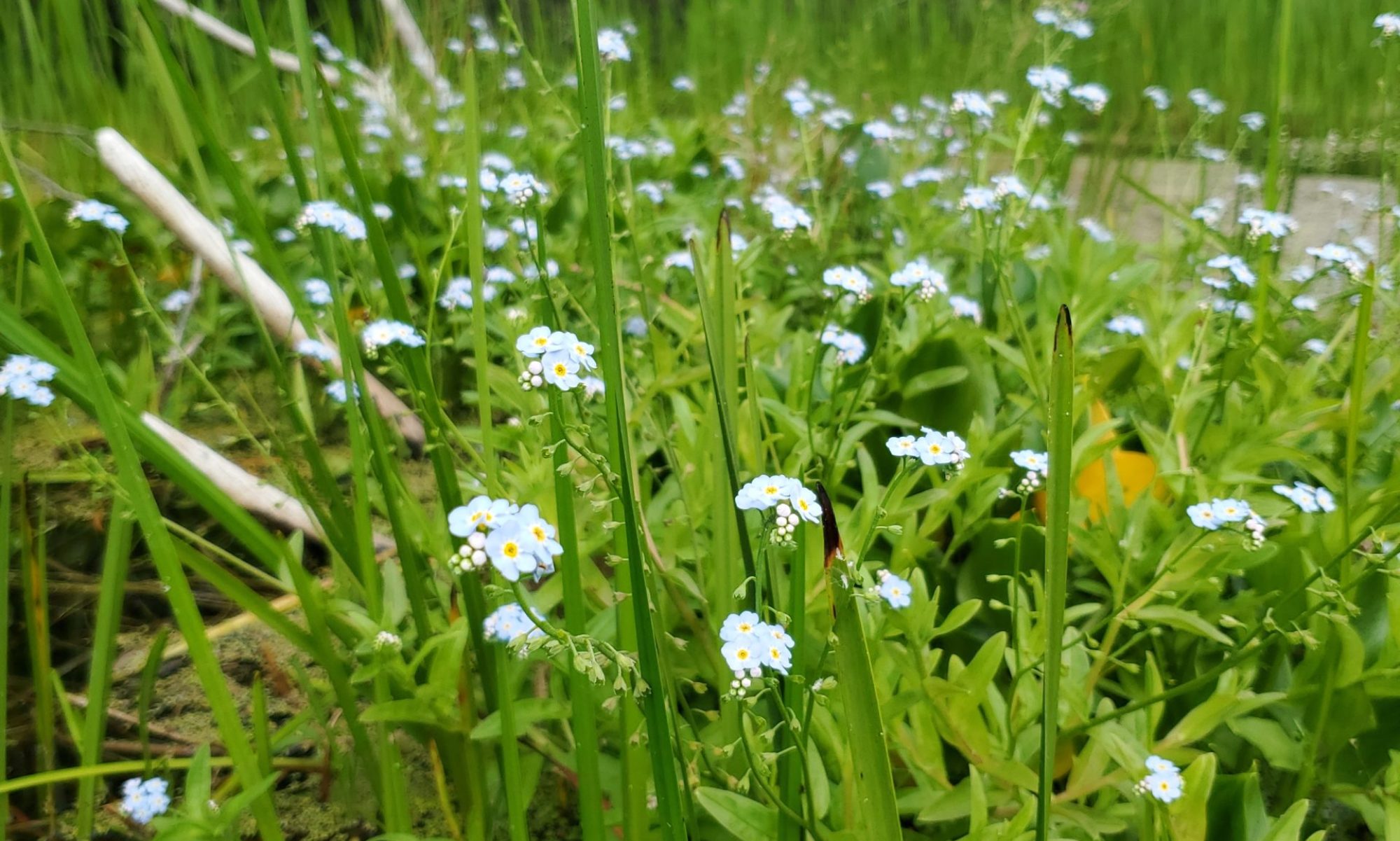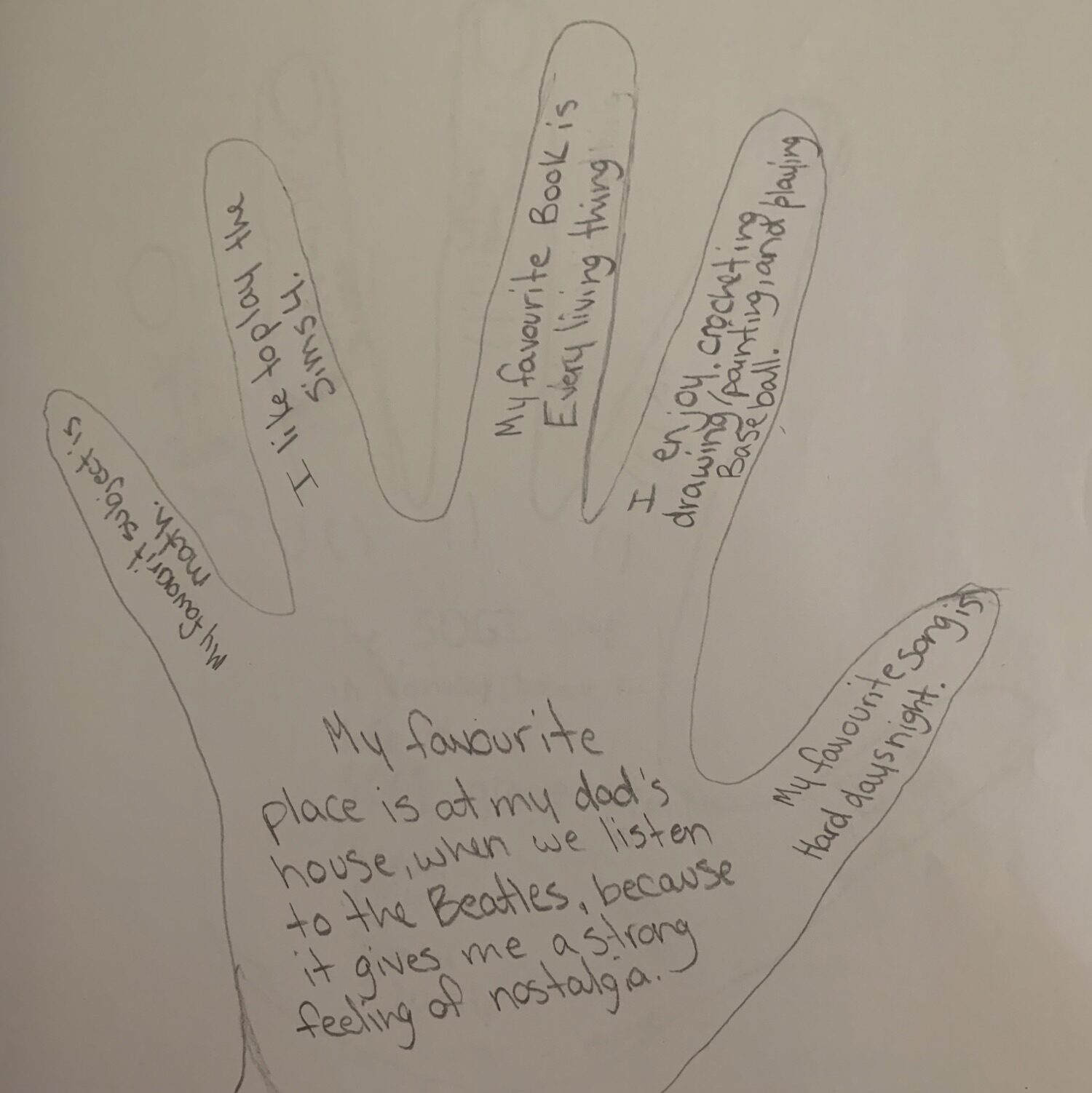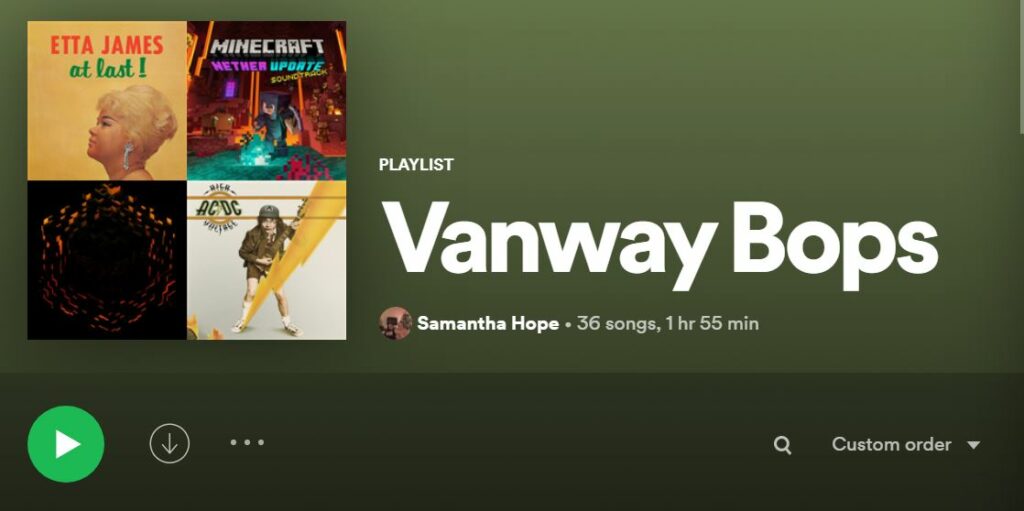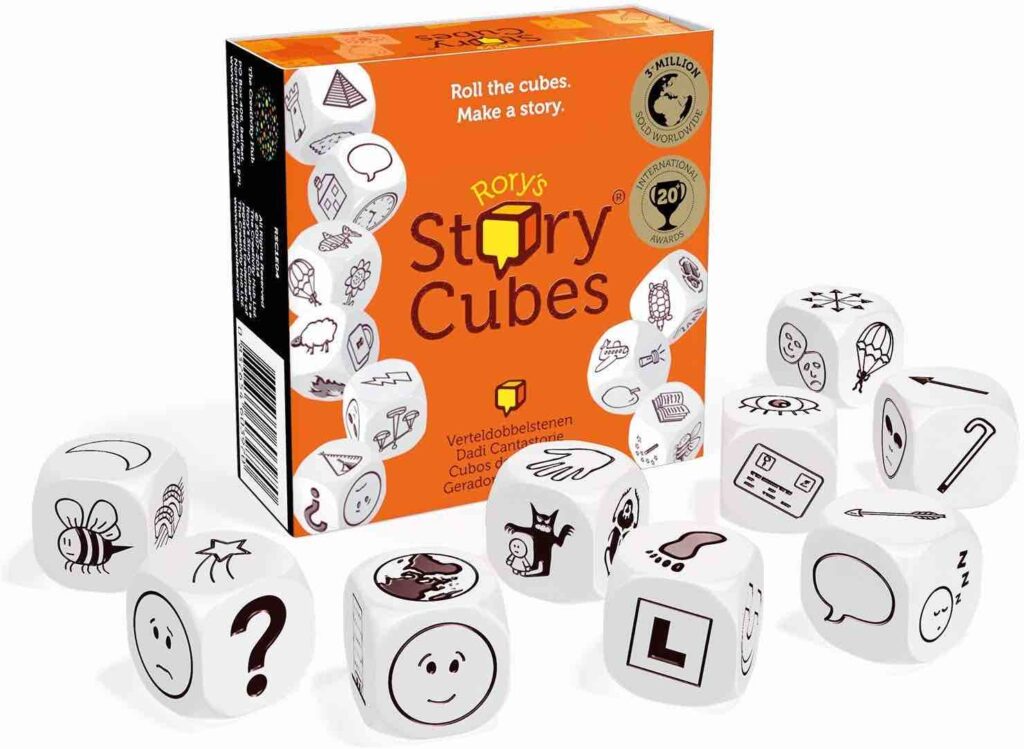For my Capstone, I struggled to find a vehicle for my metaphor of learning. I have been going through a lot of heavy struggles these last couple of months in my personal life, thus making it difficult for me to find any sort of creative thread in my mind or soul. And then, just like that (as all great ideas do), it came to me: a short story! No drawing, cutting, gluing, or any other activities that were not speaking to me. Just good old-fashioned, fictional story writing. My original intent was to write a short story geared for students in Grade 3-5 about a character named Sasha who is trying to find something that she is good at. Throughout her journey she tries, fails, loses interest, and succeeds. However, once I started writing I found it difficult to stop. This short story about a girl trying to find a new hobby turned into a 3000 word story about Sasha’s self and community exploration, her struggles with anxiety, and even her finding her space within her new school with new friends.
While writing the story, the connections to coursework and my own sense of Self came naturally. Here are my story’s connections.
EDUC 401 Career Education
The underlying theme of Career Education that I followed while writing is the process of trial and error when finding your purpose, passion, or place in life. We all go through this, all at different stages of life, and all with varied results. I also connected my writing to Spotlight on the Chaos Theory of Careers article by Katy Jordan, specifically two of it’s standards: Change is a part of life and that setbacks are an opportunity to learn. Sasha, our main character, experiences both of these standards when she is thrust into a new school and community partway through her Grade 7 year. She learns that change happens and she maintains a growth mindset while taking what she used to see as setbacks as opportunities for learning and self-discovery. I also found connections in my story to another reading we studied in class entitled Hope-Filled Engagement by Gray Poehnell and Norman E. Amundson. The main part of their studies that stuck into my story was the differentiation between skill and strength, detailing that a skill is something that you can do (no matter how well), while a strength is something that you find yourself good at. Sasha discovers this difference while she is finding her place in her new school; she discovers that she has the power to harness many skills and the motivation to find and hone in on her strengths.
EDUC 402 Diverse Classrooms
To incorporate Diverse Classrooms into the story, I wanted to focus more on plot than theory. This is because diversity is represented through all of the minor and major differences between everyone we encounter in our day to day lives, so I wanted to represent that through the characters that Sasha meets and interacts with. From Seth the Soccer Star, a boy with a full head of bright red hair and a freckled face, to William, a boy in her school that has had to use a wheelchair most of his life, all the way to Bobby, a student exploring their sexual orientation and gender identity in the SOGI club. Sasha finds ways to communicate with each of the people that she meets while trying to find her place. She also recognizes that it is because of the diversity that everyone else in her school has been able to find a space where they are most comfortable, which was her goal as well.
First Peoples Principles of Learning
I connected my story to ““Learning is holistic, reflexive, reflective, experiential, and relational (focused on connectedness, on reciprocal relationships, and a sense of place).” because through her journey of searching for her own sense of place, Sasha develops those reciprocal relationships, forms connections, and tries, fails, or succeeds at new skills. She learns soft skills like communication and courage, but also hard skills like fine motor skills and chess. Therefore making her learning holistic, reflexive, reflective, and experiential.
Self
To end my Capstone presentation, I wanted to connect my story to my own self by giving my 13-year-old self a message. To her I would say: “It really does get better from here. Change is a huge part of life, and you can either be the type of person who fights it OR you can roll with the punches and find the happiness in it all. Change is scary at first, but you get used to it, so be gentle and patient with yourself, take deep breaths, and trust that it will get easier.”
So, without any further ado, here is the story I wrote:
Sasha’s Self
“Sasha… Sasha honey, it’s time to wake up”.
Sasha slowly opened her eyes to her mother sitting on the edge of her bed, rubbing her arm. As her eyes adjusted to the dim early morning light she looked around and felt a tight feeling in her stomach. She didn’t recognize the room, the window was on the wrong side, her door the wrong colour. As her sleep wore off, she looked harder to try and ease her worries. The dresser, the quilt, the pictures on the pile of boxes in the corner. All things from her old room… her old home.
Her mom got up to open the blinds, chattering about how beautiful the snow looked out in the front yard, and how in the city there was no such thing as nice snow because it was always so dirty.
“Mom?” Sasha whispered, tucking her shoulders back under the covers.
“Yes, Sash? How are you feeling?” her mom replied, coming back to sit on the bed.
“Do I have to go today? I don’t feel well and it’s already December so it’s not like I’m going to be any more behind than I already am if I stay home for one more day.”. Sasha’s stomach continuing to tighten.
Sasha’s mom leaned in to give her a kiss on the forehead. “Oh Sash, you’ll feel better once you get there. It’s such a small school, you’ll have friends in no time.”.
But Sasha missed her old friends, at her big school in the city where she was supposed to be finishing up Grade 7. But then her mom got a new job. Her mom had already tried explaining that this was best for them both, but Sasha was having a hard time understanding how jumping into the middle of Grade 7 in a new town was at all good for her.
So, Sasha got up, got dressed, and got herself to the car where she would go to her first day of the last year of Elementary school where she knew nobody.
Once at school, Sasha felt like she was floating through the morning. Her teacher, Ms. McWalt, said something to the class about her being new to town, and every once in a while, she would catch the other students looking her way with polite smiles. Sasha kept her eyes on her hands and counted the minutes until recess.
When recess came, Sasha followed the group of students as they headed outside for some fresh winter air to run and play and refresh their minds. But, when that winter air hit Sasha’s face, the tightness in her stomach came back because when she looked around the schoolyard, she saw groups of other kids playing, talking, building snowmen, and walking around. Everybody in a group of friends, yet no groups with room for her…
Sasha turned around and went back inside. She kicked off her brand-new boots and mitts and stalked back to the classroom. The door was locked. She wandered the empty halls of the school, following the sound of voices until she peaked through a doorway and saw Ms. McWalt and a bunch of other teachers eating their lunch. Ms. McWalt locked eyes with Sasha and said “Sasha, is everything okay? You should be outside!”.
Sasha’s eyes stung with the beginnings of tears, but she swallowed hard and replied, “I’m just not used to it being so cold yet, is there somewhere inside I can stay to have my snack?”
Ms. McWalt and the other teachers looked at each other briefly and knowingly. She got up to meet Sasha at the door, guiding her down a hallway she hadn’t been before.
“The resource room is down here by the gym, you’re more than welcome to have your snack in here today. But Sasha, you should really try to spend some time outside! It’s not every day that we have sunshine AND snow.”. With that, Ms. McWalt gave Sasha a sweet smile and went back to the classroom. Sasha went into the resource room, avoiding eye contact with the resource teacher, Mr. Andrews, and had her snack alone.
Sasha later ate her lunch alone, again, in the resource room.
And she did so the next day.
And the next day.
On the morning of the fourth day, Sasha awoke to realize that something was different. The knot in her stomach was gone and her surroundings looked more like… her own bedroom! The pictures now on the wall and the boxes in the corner unpacked. It even smelled like her own room again. Instead of feeling nervous, she felt brave.
So, Sasha got dressed more confidently, looked herself in the eye as she brushed her hair and thought to herself: I am going to make friends.
Later that day while in the resource room, Sasha looked up from the table and blurted to Mr. Andrews “What do people around here even like to do?”.
Mr. Andrews glanced over top his computer to Sasha, his eyebrows creased from the surprise of Sasha finally speaking.
“Well,” Mr. Andrews said. “a lot of the other students in the school like to get involved in clubs or try out for different teams. It’s a really good way to make some friends and it gives you something to do outside of school.”.
With that, his eyes shifted back to his computer and Sasha went back to her granola bar, thinking to herself: Okay, so I can join a club, or try out for a team. But I haven’t really tried anything out before, how will I know what I’m good at or what I’ll like?
There was only one way for Sasha to find out.
After school that day, while Sasha was putting on her mittens and boot, she paid better attention to the groups of students around her trying to see what they were like, or maybe (and better yet) where they were going. As she looked around in a way that wasn’t obvious, she saw a group of kids that looked to be about her age with pinnies, running shoes, and soccer balls in their hands! Sasha quickly threw on her backpack and followed the group all the way to the gym. She stopped at the doors and looked around, there were a good handful of other students in the room, all putting their runners on and warming up by kicking the soccer ball back and forth with each other.
She peaked her head further into the room to get a better look and…
Immediately locked eyes with Mr. Andrews, who’s face lit up with a huge smile. He half jogged his way over to Sasha.
“So, soccer?’ he asked Sasha nonchalantly, trying to hide his excitement in Sasha’s presence.
“Oh, I don’t know. I think maybe I will just watch today and see if soccer is for me.” Sasha replied, heading over to a bench on the side of the gym.
“Nonsense! You’ll play. Seth here” Mr. Andrews said, gesturing towards a boy in her class with bright red hair and a face full of freckles, “is our soccer star! He’ll get you everything you need to get started.”.
Seth flashed a wide smile at Sasha. “Do you have running shoes?” he asked. Sasha smiled back and pulled her indoor shoes out of her backpack.
Sasha’s experience in soccer was… interesting. At first, she couldn’t get the hang of running AND kicking the ball with her feet, and then when that started to get easier, she found that people on her team were actually expecting her to try and score! She kicked, kicked, and kicked again but always seemed to send the ball off in a different direction than the net. No matter what she did or how hard she tried, the ball always ended up bouncing off the wrong side of her foot. Eventually, she began to feel discouraged, and she went to sit down and sip some water, feeling awfully sorry for herself.
Once Sasha sat, Seth came and sat down beside her.
“Wow!! What a great game! I love it when we all just play for fun and it doesn’t get competitive.” he said.
Sasha looked at him, feeling worse than ever about her bad aim.
“Yeah…” Sasha replied, “I just feel bad about not doing better. I can’t even get the ball near the net!”.
“Are you joking?? Nobody here can! It’s all just for fun anyways.” Seth answered. With that, he jumped back up and started playing again.
The next day, Sasha was so sore she felt as though her legs would fall off. Maybe no soccer for me today she thought to herself. Plus, she had a feeling that soccer wasn’t for her. She had fun, and definitely felt better about it all after she spoke to Seth, but she felt like her eye-foot coordination was still a little off.
So, Sasha spent another recess in the resource room with Mr. Andrews.
After having lunch, Sasha went back to the resource room to read while the other students played outside. She expected it to be empty, as it always was during recess and lunch but was surprised to hear voices… and laughter! She peeked her head around the doorframe so see a group of kids at her regular table doing a variety of activities: working on homework or projects, drawing, playing card games. Feeling more confident after the soccer practice yesterday, she held her chin up and approached the group at the table. They all looked at her, waiting.
“Um, hi. I’m Sasha, I usually spend lunch time in here.” Sasha offered, feeling her confidence begin to drain.
One girl, who Sasha recognized to be Daphne from the Grade 6 class, looked across the table at another student who Sasha had not met yet. The other student looked at Daphne and began to use sign language to translate what Sasha had just said to the group.
Sasha felt awkward because of the exchange, but still determined to make friends and discover her place in the community, she pulled out a chair and sat down.
“So,” Sasha started, looking at Daphne, “what are you all doing here at lunch?”.
Sasha waited while the other student signed her question and watched while the two had their exchange in amazement.
The other student said “We’re part of the SOGI club, we meet here once a week at lunch time to just hang out and play some games. I’m Bobby, I use they/them pronouns, by the way, and that’s Daphne, she/her, and over on the other side are Bruce, he/him and Samira, who is usually she/her but sometimes they/them.”.
Bobby looked at the puzzled look on Sasha’s face. “It stands for Sexual Orientation and Gender Identity, so pretty much it’s just a fun place to hang out once a week where we can just be ourselves and learn more about stuff that we have questions about. Mr. Andrews lets us play games or do homework or whatever while we talk.” they said.
“Oh!” Sasha exclaimed, “I get it. I’m Sasha, and I guess I am she/her. I uh, don’t really know if I fit in here though because I’ve never really heard of SOGI and I haven’t really thought much about any sort of orientation or identity.”
Sasha waited while Bobby signed what was happening to Daphne. Once they were done Daphne stood up and pointed to a poster on the wall that Sasha hadn’t noticed before. It read:
SOGI
SEXUAL ORIENTATION AND GENDER IDENTITY CLUB
ALL PEOPLE WELCOME
unless your a big meat head
Sasha giggled as she read the last line of the poster, which had obviously been scribbled down quickly with a marker.
Bruce laughed and said “That’s Bobby’s writing, we just really like our group and sometimes other people aren’t very nice to us. They call us names and it makes Bobby really mad or the rest of us really sad… it’s not that we don’t want new members, it’s just that sometimes people are…”
“Meat heads.” Sasha finished, smiling. “Can I hang out with you? I really like it here too.”
They all looked at her and smiled, making room for her at the table. Sasha stayed, played games, looked at their art work, and even learned to sign her own name.
Throughout the next week, Sasha tried to do something new every day. She tried to learn chess with a group that plays before school on Mondays but found that no matter how hard she tried she couldn’t remember the rules. Plus she didn’t really like it. On Tuesday, she asked a group if she could come with them to the horse club after school to try horseback riding, but when she got there her eyes got itchy and she couldn’t stop sneezing. Apparently, she had allergies that she didn’t know were there, people in the city often don’t see horses much, if at all. Wednesday, Sasha asked the Yearbook Club if she could help, but they told her they were full and turned her away.
Thursday she was approached by William, the only person in the whole school to use a wheelchair. Sasha wasn’t sure why but the way he manoeuvred around the dirt paths and tree roots told her that he must have had to use it for a long time. They had met a few times before when their two classes worked together on projects and he seemed very nice, so when he approached her that day after the students ate their lunch, she was willing to give another shot at friendship.
“Hey Sasha, you busy for lunch today?” William asked.
Sasha glanced down the hall towards the resource room.
“Umm, I guess not, what’s up?” she replied, feeling anxious about what William wanted from her.
“Well, our wheelchair basketball team is down a player, and I was wondering if you wanted to come and give it a try? I figured that if you’re willing to try chess then you must be up for a challenge!”
Sasha felt guilty, looking down at her perfectly capable legs. Her face went hot.
“Are you sure? I mean…” she lowered her voice and looked at her feet, “I don’t even use a wheelchair.”.
William laughed. A BIG laugh, turning himself around in a circle trying to compose himself.
“Neither does Jake, or Lauren, or Genevieve, or anyone else on the team. Our principal organized the team a few years ago when I transferred here so that I could be more included in sports. But it wouldn’t be much of a sport if I was playing against myself, would it? Lots of people around school play, you should come try it out.”
“Okay then…” Sasha replied, feeling nervous still but unable to decline.
So Sasha and William made their way to the gym, Sasha growing more and more nervous with each step. Once they reached the gym, she took a moment to breath in an effort to calm her nerves. Nothing can be as bad as sneezing so loud that you spook the horses, right?
William and the other teammates got Sasha set up and ran her through the rules. Easy enough, Sasha thought to herself, I can give it my best shot.
What Sasha didn’t expect, however, was that she loved it!! And not only that but was actually pretty good. She even got a few points for her team! Towards the end of lunch, Sasha was racing William around the gym, trying to see who could get more laps in before the bell rang.
By Friday morning, Sasha was feeling exhausted.
She decided to take the day off from finding her place in this new town, feeling as though maybe she just wouldn’t fit in. Sure, she met some people (which is better than nothing) but they were probably just being nice, right?
That recess, Sasha made her (now routine) walk to the resource room for her snack. As the door came into view, she stopped in her tracks.
The door was closed. The door was never closed.
Mr. Andrews was leaning against the wall by reception, talking to the principal about how his room could really use some new board games when he spotted Sasha.
“Hey Sasha, I think today you might have to try going outside for recess and lunch. My room’s getting a brand-new paintjob. It’s gonna look fresh.” he said to her, grinning as if someone just told him that he got a brand-new car instead of a coat of paint.
Sasha began to panic; this was not expected and not in her routine. Outside? But what was she going to do outside, without any friends? Stand there like a loser???
Mr. Andrews went back to his conversation and Sasha turned to go put on her boots and mittens, trying to take deep breaths but that feeling she had on the first day of school was coming back. She slowly stepped outside into the cold winter air and froze.
But then she relaxed.
Because when Sasha looked around her, she realized that she knew people out there, she wasn’t alone.
Over in the field she saw Seth with his bright red hair poking out from under his toque building a snowman with Samira. And by the trees she saw Bobby and Daphne and Bruce packing snowballs where the teachers couldn’t see. Over beside the school she watched as William slid his wheelchair across some black ice while his teacher hovered, and the other students laughed in excitement.
Sasha took a deep breath, finally feeling the weight of her worries lift away like a tough grass stain. She had friends, people who she was comfortable with, people she tried new experiences with, people who didn’t judge her.
Sasha could finally relax; she had found her place.
References
First Peoples Principles of Learning. First Nations Education Steering Committee FNESC. (n.d.). http://www.fnesc.ca/first-peoples-principles-of-learning/.
Jordan, K. (2020, March 9). Spotlight on the Chaos Theory of Careers. careers.govt.nz. https://www.careers.govt.nz/articles/spotlight-on-the-chaos-theory-of-careers/.
Poehnell, G., & Amundson, N. E. (2011). Hope-Filled Engagement: Creating New Possibilities in Life/Career Counselling. Ergon Communications.






